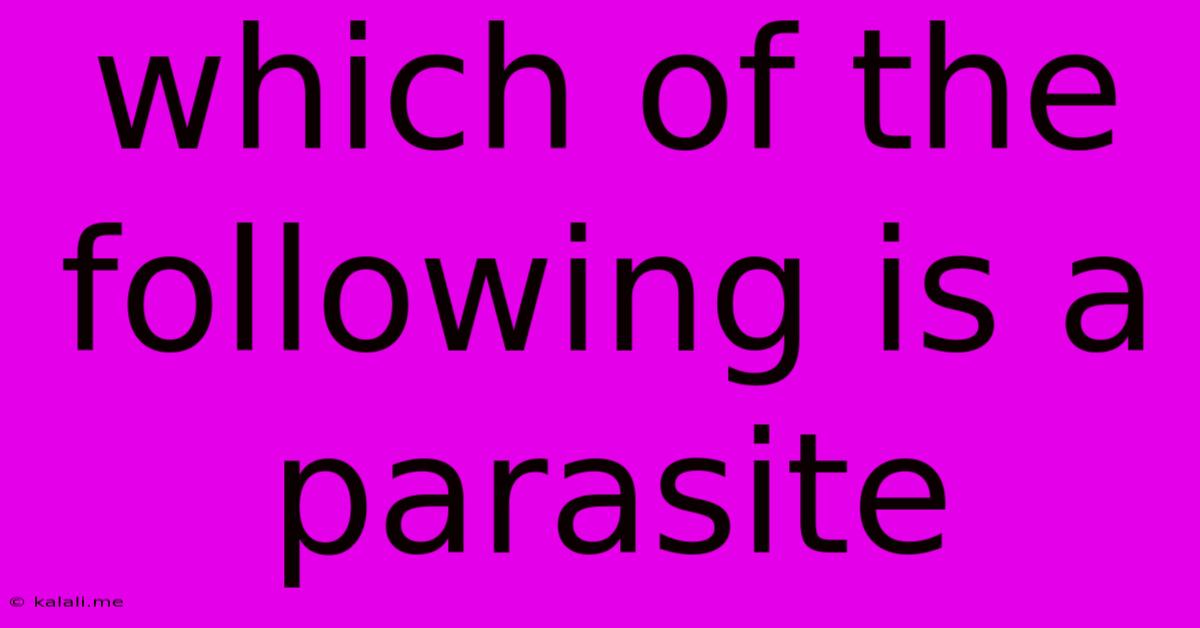Which Of The Following Is A Parasite
Kalali
Jun 12, 2025 · 3 min read

Table of Contents
Which of the Following is a Parasite? Understanding Parasitism in the Natural World
This article will explore the fascinating world of parasites, defining what constitutes a parasite and providing examples to help you distinguish them from other organisms. Understanding parasitism is crucial for appreciating the complex relationships within ecosystems and the impact parasites have on their hosts. We'll delve into the characteristics of parasitic organisms and help you identify which creatures among several choices would be classified as parasites.
What is a Parasite?
A parasite is an organism that lives on or in a host organism and gets its food from or at the expense of its host. This relationship is inherently unequal, with the parasite benefiting while the host is typically harmed, although the degree of harm can vary widely. This harm can range from minor irritation to severe illness or even death. Key characteristics of a parasitic relationship include:
- Dependence on a host: Parasites are completely reliant on their host for survival, needing it for nutrients, shelter, or both.
- Harmful effect on the host: While the degree of harm can vary, the host is always negatively impacted, at least to some extent.
- Close physical association: Parasites maintain close contact with their hosts, either internally (endoparasites) or externally (ectoparasites).
Examples of Parasites:
Many organisms exhibit parasitic lifestyles. Let's examine some common examples across various taxa:
-
Protozoa: Plasmodium, the causative agent of malaria, is a classic example of a parasitic protozoan. It lives within red blood cells, causing debilitating fever and potentially fatal illness. Other examples include Giardia and Entamoeba histolytica, which cause intestinal infections.
-
Helminths (worms): Tapeworms, hookworms, and roundworms are all examples of parasitic worms. Tapeworms live in the intestines, absorbing nutrients from their host, while hookworms attach to the intestinal wall and feed on blood.
-
Arthropods: Ticks, fleas, lice, and mites are ectoparasites that feed on the blood of their hosts. They can transmit various diseases in addition to causing irritation and itching.
-
Fungi: Some fungi are parasitic, infecting plants and animals. Examples include Cordyceps, known for its mind-controlling effects on ants, and various fungal skin infections in humans.
Differentiating Parasites from Other Organisms:
It's important to distinguish parasites from other organisms that might share some similar characteristics. For example, commensalism is a relationship where one organism benefits and the other is neither harmed nor benefited. Mutualism, on the other hand, involves both organisms benefiting from the interaction. Parasites are distinct because they always cause some level of harm to their host.
Determining which organism is a parasite from a list requires understanding these core characteristics: dependence on a host, harmful effects on the host, and close physical association.
Conclusion:
Understanding the definition and characteristics of parasites is fundamental to comprehending the intricate web of life. By identifying the dependence on a host, the negative impact on the host, and the close physical relationship, you can accurately distinguish parasites from other types of organisms. This knowledge is critical for recognizing and addressing parasitic infections, both in humans and other organisms. Remember to always consult reliable sources for information on specific parasites and their effects.
Latest Posts
Latest Posts
-
Which Test Is Not A Projective Test
Jun 13, 2025
-
Which Of The Following Is An Open Ended Question
Jun 13, 2025
-
Which Of The Following Are Not Units Of Pressure
Jun 13, 2025
-
What Is The Antonym For Hostile
Jun 13, 2025
-
Density Of Water At 4 Deg C
Jun 13, 2025
Related Post
Thank you for visiting our website which covers about Which Of The Following Is A Parasite . We hope the information provided has been useful to you. Feel free to contact us if you have any questions or need further assistance. See you next time and don't miss to bookmark.